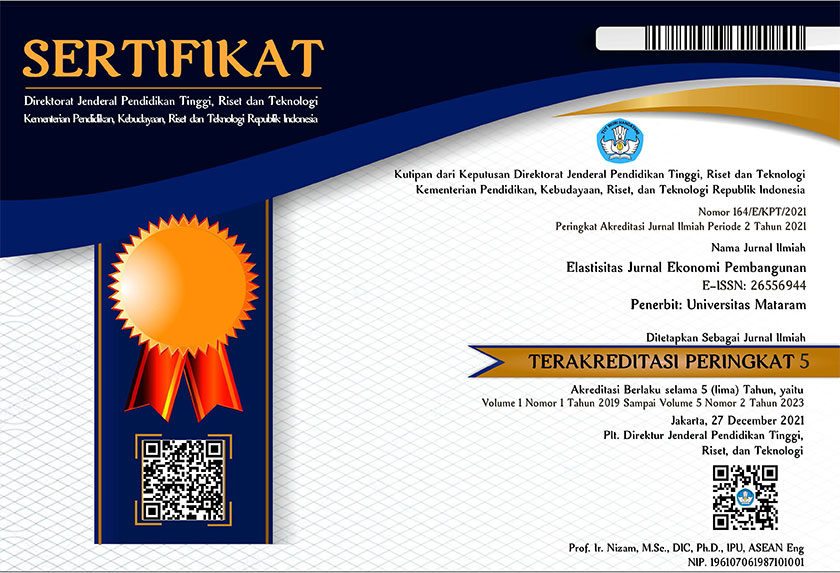EMPLOYMENT FROM A GENDER PERSPECTIVE IN BALI PROVINCE
DOI:
https://doi.org/10.29303/e-jep.v6i3Keywords:
Discrimination, Gender, Employment, DisparityAbstract
Opportunities for women and men to compete in the job market are needed to accelerate increases in community productivity. Decent employment opportunities can be seen through the unemployment approach and the level of inactivity from non-labor force indicators. Inequality in development according to gender can result in suboptimal potential obtained from development. There is still visible discrimination or inequality towards female workers and male workers that can be seen from the contribution of women's income, the number of working hours, women's participation in labor force and the involvement of women in positions in professional. This is due to the existence of stereotypes about gender, apart from that, women are also faced with their natural instincts as women in taking care of the family, which results in the contribution of women's workforce not being optimal even though their human capital is equivalent to that of men's workers
References
Aldianto, R., Jasruddin, & Quraisy, H. (2015). Kesetaraan Gender Masyarakat Transmigrasi Etnis Jawa. Jurnal Equilibrium Pendidikan Sosiologi.
Badan Pusat Statistik. (2022). Indikator Pasar Tenaga Kerja Indonesia Agustus 2022. Jakarta: Badan Pusat Statistik.
Badan Pusat Statistik. (2022). Indikator Pekerjaan Layak di Indonesia Tahun 2022. Jakarta: Badan Pusat Statistik.
Badan Pusat Statistik. (2023, 10 22). Retrieved from https://www.bps.go.id: https://www.bps.go.id/subject/40/gender.html#subjekViewTab5
Badan Pusat Statistik Provinsi Bali. (2023). Retrieved from www.bps.go.id: https://bali.bps.go.id/statictable/2018/02/27/44/kondisi-umum-ketenagakerjaan-provinsi-bali-menurut-jenis-kelamin-1995-2022.html
Badan Pusat Statistik Provinsi Bali. (2023). Retrieved from www.bps.bali.go.id: https://bali.bps.go.id/indicator/40/181/1/persentase-sumbangan-pendapatan-perempuan-provinsi-bali-menurut-kabupaten-kota.html
Badan Pusat Statistik Provinsi Bali. (2023, 10 25). Retrieved from bali.bps.go.id: https://bali.bps.go.id/subject/40/gender.html#subjekViewTab5
Becker, G. S. (1962). Investment in Human Capital: A Theoretical Analysis. Journal of Political Economy, 9-49.
BPS Provinsi Bali. (2023). Statistik Ketenagakerjaan Provinsi Bali 2022. Denpasar: BPS Provinsi Bali.
BPS RI. (2022). Kajian Penghitungan Indeks Ketimpangan Gender 2022. BPS RI.
Khotimah, K. (2009). Diskriminasi Gender Terhadap Perempuan dalam Sektor Pekerjaan. Yinyang, 158-180.
Khuza'i, M. (2013). Problem Definisi Gender: Kajian atas Konsep Nature dan Nurture. Kalimah.
Laili, M. H., & Damayanti, A. (2018). Kesenjangan Upah Antargender di Indonesia: Bukti Empiris di Sektor Manufaktur. JEPI (Edisi Khusus Call for Paper), Vol 18.
Lidya, W., Sukma and Kadir, & Kadir. (2019). Decomposition of Gender Wage Gap in Indonesia: Analysis from Sakernas Data. MPRA Paper No. 94930.
Marhaeni, A. (2011). Peran Hambatan Struktural terhadap Tingkat Keberdayaan Perempuan Bali dalam Jabatan Eselon di Provinsi Bali. Piramida.
Marhaeni, A., & Saskara, I. (2018). How Human Capital and Socio-Culture Affect . Journal of Comparative Asian Development, Vol. 17 (1), 216-231.
Nugraheni S., W. (2012). Peran dan Potensi Wanita dalam Pemenuhan Kebutuhan Ekonomi Keluarga Nelayan. Journal of Educational Social Studies, 105-111.
Purnomo, A. (2006). Teori Peran Laki-Laki dan Perempuan. Egalita.
SMERU. (2001). Dampak Kebijakan Upah Minimum terhadap Tingkat Upah dan Penyerapan Tenaga Kerja di Daerah Perkotaan Indonesia. SMERU






